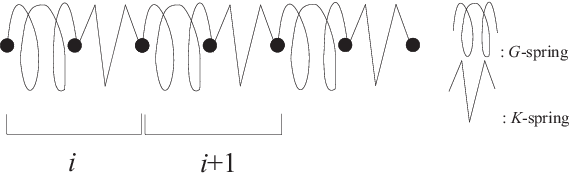
One-dimensional lattice vibrations
We investigate a chain of identical
atoms which are coupled by different kinds of springs:

Always two atoms form a unit (basis) addressed by an index \(i\).
The lattice distance shall be \(a\).
The excursion of both atoms is denominated by \(u_1\) and \(u_2\):
for the potential energy we find:
|
| \begin{equation*} U^{harm} = \frac{K}{2}\sum_n \left[u_1(na)-u_2(na)\right]^2 + \frac{G}{2}\sum_n \left[u_2(na)-u_1((n+1)a)\right]^2 \qquad . \end{equation*} | (3.19) |
The equations of motion are:
|
| \begin{equation*} \begin{split} M\ddot{u}_1(na) & = -\frac{\partial U^{harm}}{\partial u_1(na)} \\ & = -K[u_1(na)-u_2(na)]-G[u_1(na)-u_2((n-1)a)] \label{motion1} \end{split} \end{equation*} | (3.20) |
|
| \begin{equation*} \begin{split} M\ddot{u}_2(na) & = -\frac{\partial U^{harm}}{\partial u_2(na)} \\ & = -K[u_2(na)-u_1(na)]-G[u_2(na)-u_1((n+1)a)] \label{motion2} \end{split} \end{equation*} | (3.21) |
|
| \begin{equation*} \begin{split} u_1(na) & = \epsilon_1 \exp\left(i(k n a-\omega t)\right)\\ u_2(na) & = \epsilon_2 \exp\left(i(k n a-\omega t)\right) \end{split} \end{equation*} | (3.22) |
|
| \begin{equation*} \exp(ikNa) = 1\; \mbox{, i.e.} \quad k = \frac{2 \pi}{a} \frac{n}{N}, \qquad n = -\frac{N}{2}, .... , \frac{N}{2} \quad . \end{equation*} | (3.23) |
Including this into Eq. (3.20) and Eq. (3.21) we get:
|
| \begin{equation*} \begin{split} [M \omega^2-(K+G)]\epsilon_1 + (K+G e^{-i k a}) \epsilon_2 & = 0 \\ (K+G e^{-i k a}) \epsilon_1 + [M \omega^2-(K+G)] \epsilon_2 & = 0 \end{split} \end{equation*} | (3.24) |
|
| \begin{equation*} [M \omega^2-(K+G)]^2 = \left|K+G e^{-i k a}\right|^2=K^2+G^2+2KG \cos(ka) \qquad . \end{equation*} | (3.25) |
We find
|
| \begin{equation*} \omega^2(k) = \frac{K+G}{M}\pm\frac{1}{M}\sqrt{K^2+G^2+2KG \cos(ka)} \end{equation*} | (3.26) |
and
|
| \begin{equation*} \frac{\epsilon_2}{\epsilon_1} = \mp \frac{K+G e^{i k a}}{\left|K+G e^{i k a}\right|} \qquad . \end{equation*} | (3.27) |
For the \(N\) different \(k\)-values we always find two \(\omega\)-values, i.e. we find \(2N\) modes; this corresponds to the \(2N\) degrees of
freedom (2 atoms in \(N\) elementary cells).
We can choose
|
| \begin{equation*} K \gt G \qquad . \end{equation*} | (3.28) |
The both solutions are:
1)
|
| \begin{equation*} \omega(0) = \sqrt{2 \frac{K+G}{M}} \;\mbox{, and} \quad \frac{\epsilon_2}{\epsilon_1} \lt 0 \quad , \end{equation*} | (3.29) |
i.e. both atoms oscillate in anti-phase. If the atoms are charged, thus a dipole moment
would be introduced. Light can couple at this oscillations. Therefor the solution is called the optical mode.
2) We find
|
| \begin{equation*} \omega(0) = 0 \;\mbox{, and} \quad \frac{\epsilon_2}{\epsilon_1} \gt 0 \quad , \end{equation*} | (3.30) |
i.e. both atoms oscillate in phase. We will find density oscillations within the crystal. A sound wave will move through the crystal. Therefor his solution is called the acoustic mode.
© J. Carstensen (Stat. Meth.)